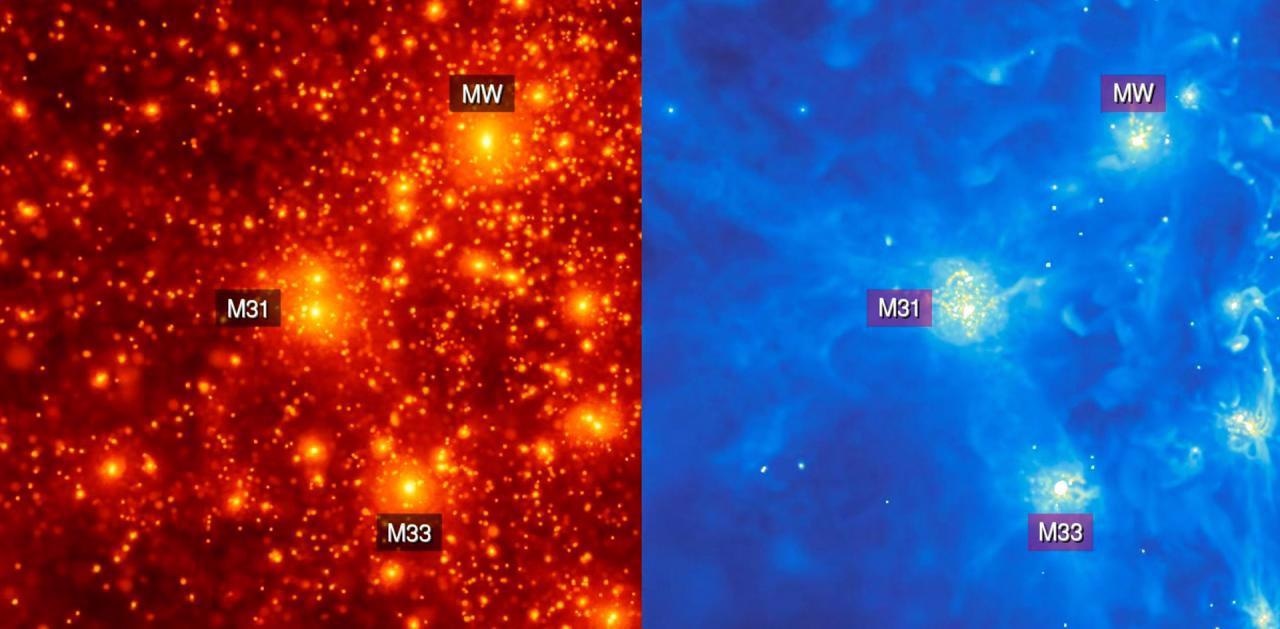In the past, a majority of the researchers believed that once a satellite galaxy passes very near to its higher mass parent galaxy, its star formation would cease since the bigger galaxy would absorb all the gas from it, making it short of material required to make new stars.
 Image of the simulated local group used for the article. Left, image of dark matter; on the right, gas distribution. The three main galaxies of the Local Group (MW, M31, and M33) are indicated. Image Credit: CLUES simulation team.
Image of the simulated local group used for the article. Left, image of dark matter; on the right, gas distribution. The three main galaxies of the Local Group (MW, M31, and M33) are indicated. Image Credit: CLUES simulation team.
For the first time, a group of researchers headed by scientists at the Instituto de Astrofísica de Canarias (IAC), Arianna di Cintio, has demonstrated that this is not always the case. They arrived at this conclusion through numerical simulations. The findings were recently reported in the Monthly Notices of the Royal Astronomical Society (MNRAS) journal.
The team performed advanced simulations of the whole of the Local Group of galaxies, which includes the Milky Way, the Andromeda galaxy and their respective satellite galaxies, and showed that the satellites not only can maintain their gas but can also undergo several new episodes of star formation right after passing closer to the pericenter of their parent galaxy (the least distance they reach from its center).
The Local Group’s satellite galaxies exhibit an extensive range of star formation histories, the origin of which has not been understood completely earlier. The researchers used hydrodynamic simulations within the project called Constrained Local UniversE (CLUES) to study the star formation histories of satellite galaxies that are almost the same as those of the Milky Way in a cosmological context.
In most cases, the gas of the satellite is drained by the parent galaxy by its gravitational action and transports itself to the bigger galaxy, thereby hampering star formation in the satellite, through a process called accretion. In about 25% of the sample, the researchers discovered that star formation was improved by this interactive process.
The study findings demonstrate that the star formation peaks are associated with the close pass of the satellite near the parent galaxy, and at times, by the interaction of two satellites. The team found two main features of the star formation.
Firstly, the satellite should enter the parent galaxy with a huge reserve of cold gas, and a minimum distance not too small, to enable the development of stars as a result of compression of the gas. On the other hand, galaxies that tend to pass very close to the parent galaxy, or a parent galaxy with very little gas, are stripped of their gas and, therefore, lose the chance to develop new stars.
The passage of satellites also coincide with peaks in the star formation of their parent galaxies, which suggests that this mechanism causes bursts of stars equally in both parent galaxies and satellites, in agreement with recent studies of the history of star formation in the Galaxy.
Arianna di Cintio, Study Lead Author, Instituto de Astrofísica de Canarias
“This is very important when we try to understand how star formation is produced in the smaller dwarf galaxies of our Local Group, an unresolved question,” added di Cintio.
The results of this study will provide new insights into the episodes of star formation noted in the dwarf galaxies of the Local Group, like Fornax and Carina. This could help to provide an appealing explanation for their presence. Also, a revision of the theoretical models employed to describe the formation of stars in dwarf galaxies is highly essential.
Journal Reference:
Di Cintio, A., et al. (2021) Pericentric passage-driven star formation in satellite galaxies and their hosts: CLUES from Local Group simulations. Monthly Notices of the Royal Astronomical Society. doi.org/10.1093/mnras/stab1682.